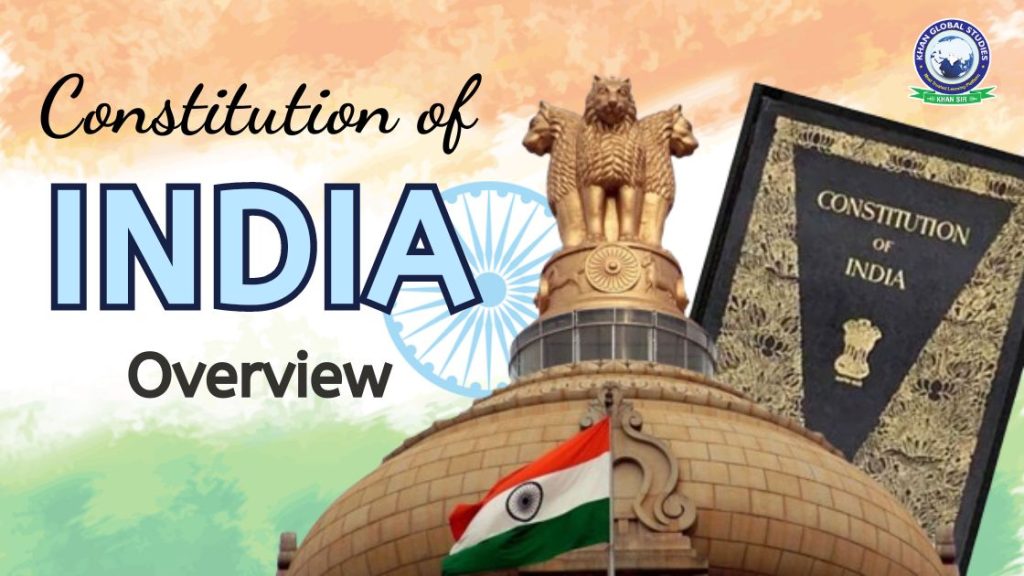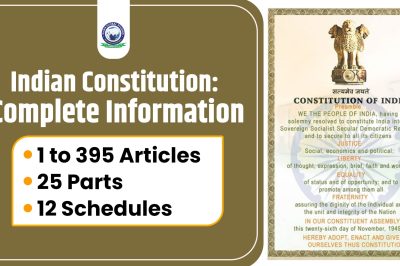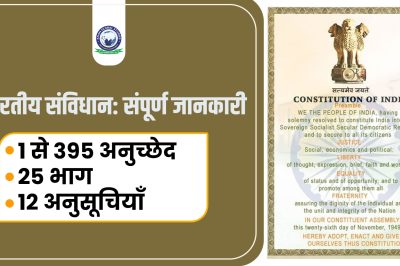The Constitution of India is important for democracy and secularism. The Constitution was adopted by the Constituent Assembly on 26 November 1949. After this, the Indian Constitution came into force on 26 January 1950. This day is celebrated every year in India as Republic Day. The Government of India Act 1935 is considered the basic basis of the Constitution of India.
| Constitution of India Overview | |
| Passed by | Constitution Assembly |
| Making Time | 2 Years 11 Months 18 Days |
| Date of Implementation | 26 January 1950 |
| Producer | Dr. Bhim Rao Ambedkar |
What is the Constitution?
The Constitution of India is known as the longest-written constitution in the world. Its written statement outlines the ideals and objectives of the Constitution such as justice, liberty, and equality. The Constitution is the supreme law of India and it is a written document.
The Indian Constitution sets out the structure, procedures, powers, duties of the government and its organizations and the rights of the citizens. The Indian Constitution had 395 articles and 8 schedules contained approximately 145,000 words and is the largest constitution ever written.
Each article of the Constitution was debated by the members of the Constituent Assembly, which met for 11 sessions and 167 days over 2 years and 11 months to produce the Constitution. According to Article 79 of the Constitution of India, the Council of Parliament of the Union consists of the President and two Houses, known as the Council of States (Rajya Sabha) and the House of the People (Lok Sabha).
What is the history of the Constitution?
In 1928 the All-Party Conference convened a committee in Lucknow to draft a Constitution of India, which came to be known as the Nehru Report.
From 1857 to 1947, most of India was under direct British rule. After independence, it became clear that there was a need to make a new constitution. But for this, there was a need to bring the whole of India into the Union. This meant that the princely states needed to be persuaded to become part of the Indian Union through force or diplomacy.
Sardar Vallabhbhai Patel and VP Menon did this incredible work. Until this happened, India was still legally under the British, but the Constitution of India repealed the Indian Independence Act 1947 and the Government of India Act 1935 when it came into force on 26 January 1950. A sovereign democratic republic with a constitution.
The development of the Indian Constitution includes the Regulating Act of 1773, Pitt’s India Act of 1784, Charter Act of 1813, Charter Act of 1833, Charter Act of 1853, Government of India Act of 1858, Indian Council Act of 1861, Indian Council Act of 1892, Morley-Minto Reforms 1909. Montagu-Chelmsford Reforms 1919, Government of India Act 1935, and Indian Independence Act 1947 were helpful.
About the Preamble of the Constitution
The Preamble of the Constitution is called the soul of the Indian Constitution. It is an integral part of the Constitution and the objective resolution describing the constitutional structure was introduced by Jawaharlal Nehru in 1946. The Preamble of the Constitution was adopted on 22 January 1947, which reads as follows:
We, the people of India, have resolved to establish India as a sovereign, socialist, secular, democratic Republic and to ensure to all its citizens social, economic and political justice, freedom of thought, expression, faith, belief and worship, dignity and Let’s resolve to. Let’s take a resolution. Let’s take a resolution. Let’s take a resolution. opportunity. We resolve to adopt, enact and dedicate this Constitution in our Constituent Assembly today on 26th November 1949 (Miti Margashirsha Shukla Saptami, Samvat 2006 Vikrami).
When was the first meeting of the Constituent Assembly of India held?
- The Constituent Assembly was formed on 6 December 1946 and completed the process of constitution-making by holding 166 meetings in 2 years, 11 months and 18 days.
- The first meeting of the Constituent Assembly of India took place on 9 December 1946. This meeting served as the first Parliament of independent India and its main function was to draft a constitution for India. Dr. Rajendra Prasad was a great fighter, lawyer, and scholar of the Indian freedom struggle and was elected the first Speaker of the Constituent Assembly.
- Initially, it had 389 members, but after the partition of the country into India and Pakistan, when some members went to Pakistan, this number came down to 299.
- Of these 299, 229 were from British Indian provinces while the remaining 70 were from princely states. Sachchidanand Sinha, the oldest member, was elected the first Speaker (temporary) of the Assembly. Later Dr. Rajendra Prasad was elected President and Harendra Kumar Mukherjee was elected Vice President. BN Rao was made constitutional advisor.
- In the first session, Jawaharlal Nehru said ‘The first task of this assembly is to liberate India through the new Constitution, to feed the hungry and clothe the people and to give full opportunity to every Indian to develop himself accordingly.’
- The ‘Objective Resolution’ was presented by Pandit Jawaharlal Nehru on December 13, 1946, which provided the precise philosophy and guiding principles.
- On 15 August 1947, the power of the British Empire was handed over to India and this was possible with the cooperation of countless freedom fighters.
- The Constitution was drafted on 29 August 1947 by 299 representatives of different castes, regions, religions etc. and included both men and women. The Drafting Committee and its members had considerable influence in the drafting of the Indian Constitution at various stages of the committee’s deliberations and in the Constituent Assembly.
- 26 November 1949 is known as Constitution Day or National Law Day. This day is celebrated to mark the adoption of the Constitution of India.
- Its last session was conducted on 24 January 1950. The drafting committee was headed by Dr B.R. Did it? was did. Ambedkar had presented a detailed draft of the Constitution.
When was the last meeting of the Constituent Assembly held?
The last meeting of the Constituent Assembly was held on 24 January 1950, before the Constitution of India came into force on 26 January 1950. Three major actions taken in this meeting gave a new direction to the country. In this last meeting, the members of the Constituent Assembly approved the implementation of the Constitution. In this, the national anthem and national anthem of India were selected.
In the meeting, the Chairman of the Constituent Assembly, Dr. Rajendra Prasad said that ‘Jana Gana Mana’ has been made the national anthem. After this, returning officers were made for the presidential elections. At that time, the Secretary of the Constituent Assembly, HVR Iyengar, said that there was only one nomination of Dr. Rajendra Prasad for the Presidential election, so everyone unanimously agreed on the name of Dr. Rajendra Prasad and he became the first President. constituent Assembly. Country.
How many committees were there in the Constituent Assembly?
Various committees were formed by the Constituent Assembly to look after various departments of constitution-making for independent India. The Constituent Assembly had a total of 22 committees. Of these, only 8 were the most important committees, while the rest were small and subsidiary committees.
Important committees of the Constituent Assembly and their presidents
The important committees of the Constituent Assembly and their chairpersons are as follows:
| Name of Committee | Chairman |
| Rules of Procedure Committee | Rajendra Prasad |
| Steering Committee | Rajendra Prasad |
| Finance and Staff Committee | Rajendra Prasad |
| Credential Committee | Alladi Krishnaswamy Aiyari |
| House Committee | B Pattabhi Sitharamayya |
| Trade Committee Order | K.M. Munsi |
| Ad Hoc Committee on National Flag | Rajendra Prasad |
| Committee on the Functions of the Constituent Assembly | G.V. Mavalankar |
What is the function of the Constitution?
The constitution of a country is a set of written rules that are accepted by all the people living together in a country. The functions of the Constitution are as follows:
- To clarify the structure of governance.
- To create an ideal governance structure.
- To clarify the objectives of the government.
- To protect the rights and freedoms of citizens.
- Providing ideological support and legitimacy to states.
- It expresses the aspirations of the people to build a good society.
- It is a level of trust that is necessary for different types of people to live together.
- It sets limits on the powers of the government and tells us what the rights of the citizens are.
- The Constitution is the supreme law that determines the relationship between the people living in a territory and the relationship between the people and the government.
What is the importance of the Constitution?
The Constitution is very important in India because it decides who has the power to make decisions in the society. It decides how the government is formed. There may be limits to what a government can impose on its citizens. The Fundamental Rights of the people are a gift of the Constitution and enable the government to fulfil the wishes of the society. The Constitution can limit the powers of the government and give the people the right to form a monarchy.
What is the speciality of the Constitution of India?
The features of the Constitution of India are as follows:
India’s constitution is the largest in the world. When it was launched on 26 January 1950, it contained 395 articles divided into 22 parts with 8 schedules. Over time, it grew to include 448 articles in 25 parts and 12 schedules. Our Constitution is special because it is not as strict as the American Constitution and not as flexible as the British Constitution. It is a mixture of both.
The powers of the government in India are divided between the central government and the state governments. The Constitution divides the powers of the three state branches – the executive, the judiciary and the legislature. The Constitution of India provides fundamental rights to its citizens. Along with these rights, there is also a list of 11 responsibilities, which are called fundamental duties. These duties include showing respect for the national flag and national anthem, promoting the unity and integrity of the country and protecting public property.
It is because of the Constitution that India functions as a republic, which means that it is not ruled by any dictator or king and the government is by the people, for the people and by the people.
Some Points about the Constitution of India
- The Constituent Assembly adopted the Constitution of India on 26 November 1949.
- The Indian Constitution holds supreme judicial significance in India.
- It is the world’s longest-written constitution.
- The Constitution of India is a living document, as it can be amended.
- It declares India to be a sovereign, socialist and secular republic.
- The Constitution of India talks about equality of opportunity and fraternity among the citizens.
- Many features of the Indian Constitution have been taken from other constitutions of the world.
- The original Constitution of India had 395 articles, 22 parts and 8 schedules.
- The Constitution of India has kept the judiciary independent from the legislature and the executive.
- Father of the Indian Constitution, Dr Bhimrao Ambedkar.
Interesting facts about the Indian Constitution
Interesting facts about the Constitution are as follows:
- Indian Constitution is a book of rules.
- The Constitution of India came into effect on 26 January 1950.
- The Indian Constitution guides and governs the smooth functioning of the government machinery.
- The Indian Constitution has influenced the constitutions of other countries.
- The Indian Constitution emphasizes ensuring justice, liberty, equality and fraternity for all its citizens.
- The Indian Constitution treats every citizen of India equally.
- The Constitution has kept the judiciary as an independent institution.
- The Constitution of India states its supremacy which cannot be abolished by the Parliament.
- The Indian Constitution currently has 448 articles with 12 schedules after 104 amendments.
- The Constitution of India gives many important rights to the citizens.
- The Constitution of India was completed in 2 years, 11 months and 18 days.
- Before drafting the Indian Constitution, Dr. B.R. Ambedkar had studied the constitutions of 60 countries.
- The Constitution of India is the second longest active constitution after the Constitution of Alabama.
- Our Constitution has experienced many amendments since its inception.
- The first meeting of the Constituent Assembly was held on 9 December 1946 in the Parliament House.
- Our Constitution has provided some fundamental rights to every citizen of the country.
- Our Constitution is necessary for India to remain a democratic and secular nation.
- It was drafted by 389 members of the Constituent Assembly.
Must Read:
Indian Constitution: Complete Information about Articles, Parts & Schedules





